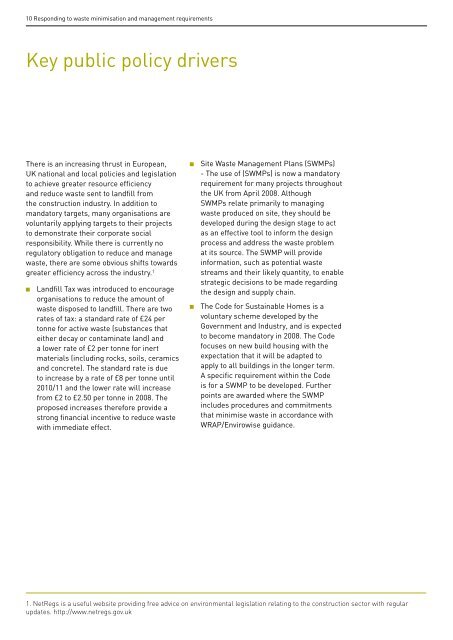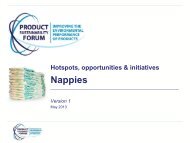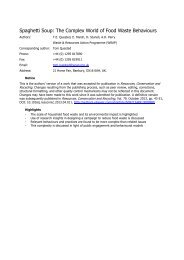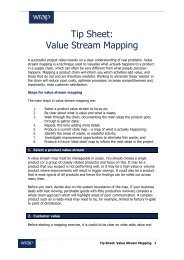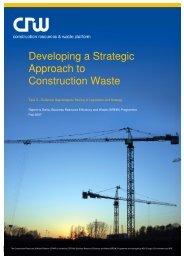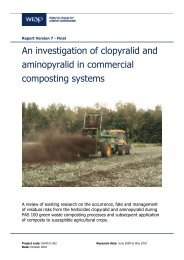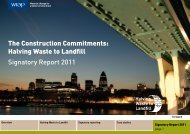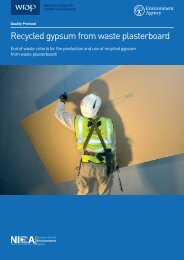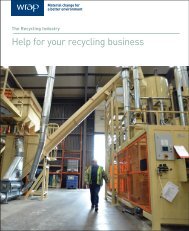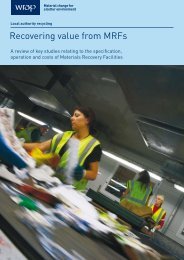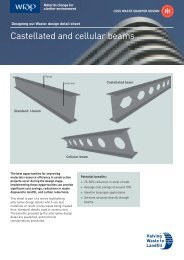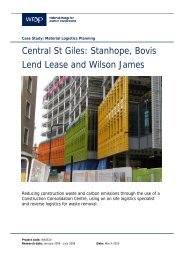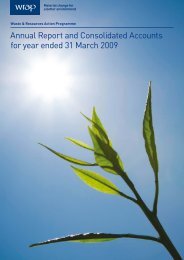Responding to waste minimisation and management ... - Wrap
Responding to waste minimisation and management ... - Wrap
Responding to waste minimisation and management ... - Wrap
You also want an ePaper? Increase the reach of your titles
YUMPU automatically turns print PDFs into web optimized ePapers that Google loves.
10 <strong>Responding</strong> <strong>to</strong> <strong>waste</strong> <strong>minimisation</strong> <strong>and</strong> <strong>management</strong> requirements <strong>Responding</strong> <strong>to</strong> <strong>waste</strong> <strong>minimisation</strong> <strong>and</strong> <strong>management</strong> requirements 11<br />
Key public policy drivers<br />
The true cost of <strong>waste</strong><br />
There is an increasing thrust in European,<br />
UK national <strong>and</strong> local policies <strong>and</strong> legislation<br />
<strong>to</strong> achieve greater resource efficiency<br />
<strong>and</strong> reduce <strong>waste</strong> sent <strong>to</strong> l<strong>and</strong>fill from<br />
the construction industry. In addition <strong>to</strong><br />
m<strong>and</strong>a<strong>to</strong>ry targets, many organisations are<br />
voluntarily applying targets <strong>to</strong> their projects<br />
<strong>to</strong> demonstrate their corporate social<br />
responsibility. While there is currently no<br />
regula<strong>to</strong>ry obligation <strong>to</strong> reduce <strong>and</strong> manage<br />
<strong>waste</strong>, there are some obvious shifts <strong>to</strong>wards<br />
greater efficiency across the industry. 1<br />
L<strong>and</strong>fill Tax was introduced <strong>to</strong> encourage<br />
organisations <strong>to</strong> reduce the amount of<br />
<strong>waste</strong> disposed <strong>to</strong> l<strong>and</strong>fill. There are two<br />
rates of tax: a st<strong>and</strong>ard rate of £24 per<br />
<strong>to</strong>nne for active <strong>waste</strong> (substances that<br />
either decay or contaminate l<strong>and</strong>) <strong>and</strong><br />
a lower rate of £2 per <strong>to</strong>nne for inert<br />
materials (including rocks, soils, ceramics<br />
<strong>and</strong> concrete). The st<strong>and</strong>ard rate is due<br />
<strong>to</strong> increase by a rate of £8 per <strong>to</strong>nne until<br />
2010/11 <strong>and</strong> the lower rate will increase<br />
from £2 <strong>to</strong> £2.50 per <strong>to</strong>nne in 2008. The<br />
proposed increases therefore provide a<br />
strong financial incentive <strong>to</strong> reduce <strong>waste</strong><br />
with immediate effect.<br />
Site Waste Management Plans (SWMPs)<br />
- The use of (SWMPs) is now a m<strong>and</strong>a<strong>to</strong>ry<br />
requirement for many projects throughout<br />
the UK from April 2008. Although<br />
SWMPs relate primarily <strong>to</strong> managing<br />
<strong>waste</strong> produced on site, they should be<br />
developed during the design stage <strong>to</strong> act<br />
as an effective <strong>to</strong>ol <strong>to</strong> inform the design<br />
process <strong>and</strong> address the <strong>waste</strong> problem<br />
at its source. The SWMP will provide<br />
information, such as potential <strong>waste</strong><br />
streams <strong>and</strong> their likely quantity, <strong>to</strong> enable<br />
strategic decisions <strong>to</strong> be made regarding<br />
the design <strong>and</strong> supply chain.<br />
The Code for Sustainable Homes is a<br />
voluntary scheme developed by the<br />
Government <strong>and</strong> Industry, <strong>and</strong> is expected<br />
<strong>to</strong> become m<strong>and</strong>a<strong>to</strong>ry in 2008. The Code<br />
focuses on new build housing with the<br />
expectation that it will be adapted <strong>to</strong><br />
apply <strong>to</strong> all buildings in the longer term.<br />
A specific requirement within the Code<br />
is for a SWMP <strong>to</strong> be developed. Further<br />
points are awarded where the SWMP<br />
includes procedures <strong>and</strong> commitments<br />
that minimise <strong>waste</strong> in accordance with<br />
WRAP/Envirowise guidance.<br />
There is potential for <strong>waste</strong> <strong>minimisation</strong> <strong>and</strong><br />
better on site <strong>waste</strong> <strong>management</strong> <strong>to</strong> positively<br />
affect a company’s bot<strong>to</strong>m line through<br />
greater efficiency in the use of materials,<br />
resulting in cost savings not only<br />
in the reduction of skip hire <strong>and</strong> l<strong>and</strong>fill<br />
charges but through the use of more<br />
efficient working practices.<br />
The true cost of <strong>waste</strong> is not just a <strong>waste</strong><br />
contrac<strong>to</strong>r’s fee; <strong>to</strong> this one must add the<br />
cost of the materials being <strong>waste</strong>d <strong>and</strong> the<br />
time <strong>and</strong> resources gong in<strong>to</strong> the process of<br />
disposal. The true cost of filling <strong>and</strong> disposing<br />
of one skip with mixed construction <strong>waste</strong> in<br />
one study was found <strong>to</strong> be £1,342. Although<br />
the skip hire was only £85, the labour cost<br />
<strong>to</strong> fill it was £163 whilst the cost of unused<br />
material in the skip was the most significant<br />
at £1,095. Other additional costs included the<br />
loss of not selling <strong>waste</strong> for salvage <strong>and</strong> poor<br />
packaging or overfilling of skips leading <strong>to</strong><br />
double h<strong>and</strong>ling.<br />
Such an evaluation could be time consuming<br />
for every project. However, the table <strong>and</strong><br />
calculation on the next page provide the<br />
facility for a quick estimate of the cost of<br />
disposing <strong>waste</strong> <strong>and</strong> can give you an idea of<br />
the potential financial gains available through<br />
better <strong>waste</strong> <strong>management</strong> <strong>and</strong> <strong>minimisation</strong>.<br />
Table 1 provides approximate data on disposal<br />
costs for the main <strong>waste</strong> streams reported by<br />
<strong>waste</strong> <strong>management</strong> contrac<strong>to</strong>rs.² Taking the<br />
information from this table (column E) <strong>and</strong><br />
multiplying by the material <strong>waste</strong> <strong>to</strong>nnage<br />
on your project will give you an indication of<br />
the potential cost savings available through<br />
undertaking initiatives <strong>to</strong> reduce <strong>and</strong> recover<br />
<strong>waste</strong>. This will be an underestimate of the true<br />
cost of <strong>waste</strong> as it excludes labour costs <strong>and</strong><br />
the forgone income of not salvaging materials.<br />
1. NetRegs is a useful website providing free advice on environmental legislation relating <strong>to</strong> the construction sec<strong>to</strong>r with regular<br />
updates. http://www.netregs.gov.uk<br />
2. Cost of £120 for a 12 cu yard skip obtained as an approximate price guide from a major construction contrac<strong>to</strong>r; approximate <strong>to</strong>nnage<br />
of <strong>waste</strong> per 12 cu yard skip is an estimation provided by an experienced Quantity Surveyor; approximate cost of material per <strong>to</strong>nne was<br />
estimated from best fit figures in the SPONS guide


